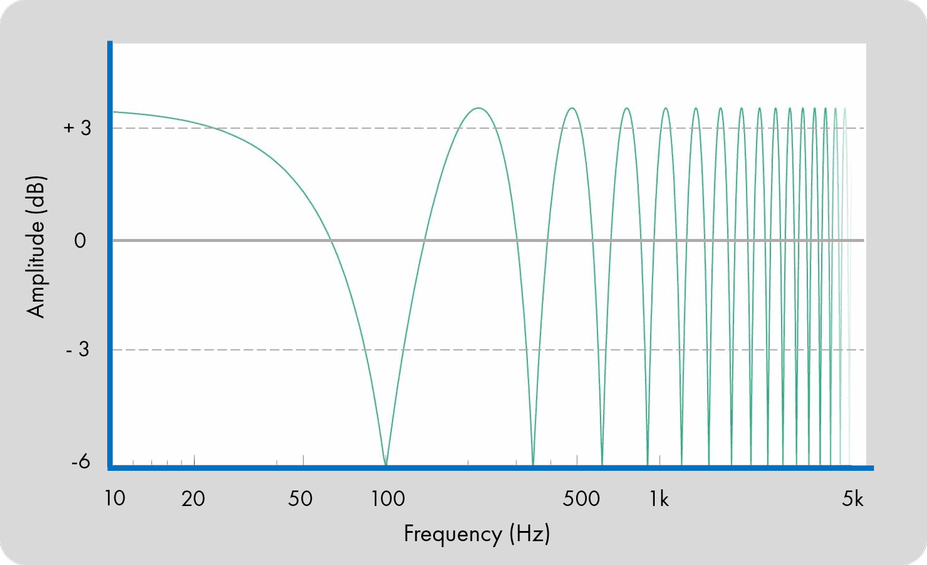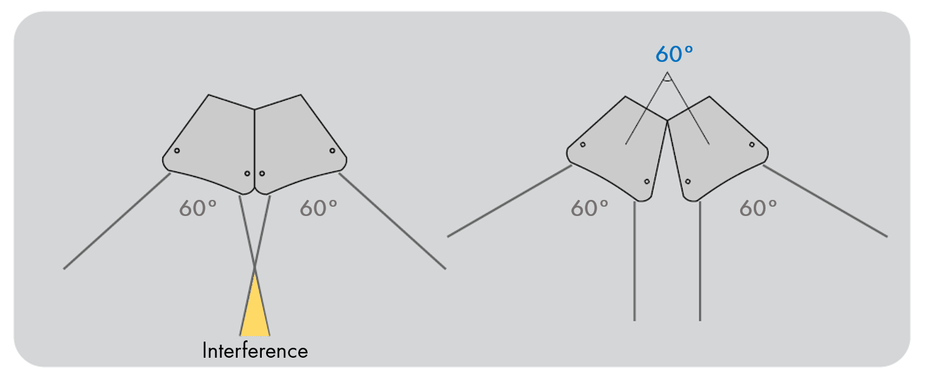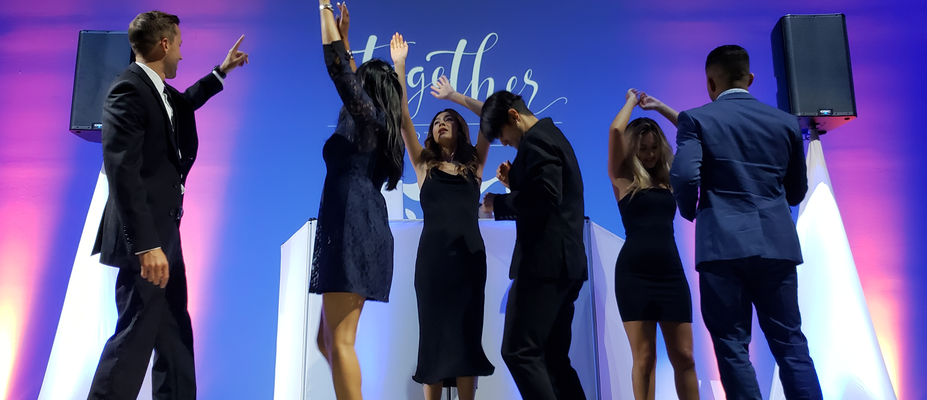Have you ever had an experience at a live event, like a concert or a show, where the sound seemed thin, lacking in punch and dynamics, or with a disturbing phasing effect as you moved around? If the sound system was comprised of a number of loudspeakers either stacked or placed side by side, or if the sound was clearly reflected by nearby walls or other large perpendicular surfaces, what you might have heard are the effects of comb filtering.
To understand this phenomenon it is useful to first recall what is phase interference, and more specifically, destructive phase interference. When a first waveform is presented to a second waveform that has the exact same size but is perfectly out of phase (180 degree), the result is a complete cancellation. The two waveforms add together to equal nothing, and this is called destructive phase interference.
Comb filtering occurs when certain frequencies are either amplified or attenuated by the superposition of a delayed version of the original audio signal onto itself. In addition, in order for this comb filtering effect to happen, the level of the signals must be within 10 dB from each other. The resulting frequency response curve of a comb filter consists of a series of regularly spaced notches, giving the appearance of a comb for the hair.

This superposition leads to certain cancellations and amplifications in the audio spectrum that in turn produce a subjectively metallic sound. Voices sound harsh and sharp due to significant parts of their fundamental frequency range being absent.
Comb filters become particularly disturbing when they change over time, as it can happen when the sound source (e.g. a musician/instrument) or the microphone moves during the performance or recording process. As a result, the first reflections are continuously changing and the comb filter in turn migrates across the audio spectrum. This overall time-varying attenuation and amplification of different frequencies is called ‘phasing’.
The critical Time Window for Comb Filtering
The form and strength of the comb filter effect depends on the length of time between the original and the delayed sounds. In the case of a direct sound and its reflection from a boundary, if the strongest reflection occurs less than 2 ms after the original sound, any comb filter that may occur is not very disturbing as only high frequencies are affected within this very short time window. As the delay/reflection-time approaches 10 ms, the comb filter cancellations and amplifications move into the fundamental tone range, and the comb filter effect becomes more audible and problematic.
If the first reflections arrive later than 35 ms, the human ear manages to separate the two sound events (direct sound and its reflection). The comb filter effect becomes weaker and eventually disappears completely when the time delay between the two sound events increases enough.
Sound reflections are not the only real-world phenomenon that can cause comb filtering. Multiple loudspeakers and multiple microphones can also lead to comb filtering effect. Let’s explore further these three situations and understand how to avoid problematic comb filtering.
Comb Filtering caused by Sound Reflections
Any time a sound is produced, it radiates from the source and bounces off of nearby hard surfaces. As an example, when miking or recording a snare drum, when the drummer hits the snare skin, the emitted sound will travel to the microphone as well as to nearby walls in the room. Reflections obviously also occur from tabletops, floors and ceilings, as well as from furniture elements, windows, etc.
As reflected sounds travel a further distance than the direct sound, they arrive at our ears or at a microphone later. Both signals are identical, but one signal is delayed by a few milliseconds, causing a comb filter, where some frequencies are cancelled and some are summed.
In order to avoid comb filtering caused by reflections, a few tips can be followed. First, as sound wave energy decreases rapidly over distance, try to use this to your advantage and place microphones as close to the sound source as possible. This way, direct sound level will be significantly louder than the one of the reflected sounds.
The other effective method is to focus on absorbing the early reflections (or first reflections) that reach the listener or microphone. Alternatively, diffusing first reflections by scattering them in many different directions will clearly attenuate the amount of energy coming back to the listener or microphone. There are many ways to diffuse and absorb reflections, which are not detailed in this article.
Comb Filtering caused by Multiple Loudspeakers
Any time an identical signal is sent to multiple loudspeakers, there is a chance comb filtering will occur. In stereophonic reproduction, left and right loudspeakers are placed equidistant from each other. Both direct sounds will reach the listening position and your ears at the same time with all frequencies perfectly in phase. No comb filtering will happen.
However, in any non-ideal environment where the listening does not take place precisely at the defined listening position, comb filtering will occur as the listener is sitting closer to one loudspeaker than the other, causing some frequencies to cancel and others to sum together.
The stereo issue above is also present in live sound applications, together with the problem of time-alignment of loudspeakers for large audience areas. In these applications, multiple loudspeaker systems are required and additional loudspeakers beneath balconies often complement the main loudspeaker array. If the system is not properly set up, the sound from the main loudspeaker array will reach the balcony loudspeaker with a delay, causing comb filtering.
Here are some advices to reduce this phenomenon. For live sound applications in large venues, sound technicians attempt to synchronize sounds from all loudspeakers using different delay times for each line array loudspeaker system (ex: QSC KLA or WideLine Series). It is an effective solution, even though time alignment between loudspeakers can only ever be optimized in one spot. Standing off–axis from the main left and right line array systems will provide, in all cases, some compromises. Slight comb filtering issues will always exist with multiple sound sources.
If the goal is to cover a large area using point-source loudspeakers (ex: QSC CP, K.2 or KW Series), first make sure to select loudspeaker models that have a very controlled directivity. By placing, each loudspeaker in such a way that there is the least possible overlap between their coverage will ensure there is almost no comb filtering occurring.
As an example, let’s use two KW152 loudspeakers, which have a nominal sound coverage of 60 degrees and their side walls built at 18 degrees. If both enclosures are set side-by-side, the resulting splay angle will be 36 degrees and the overlapping energy will create severe comb filtering interference within the listening area. Using a wider 60 degrees splay between the loudspeakers will ensure minimum overlap and broaden the total coverage angle to 120 degrees.

Comb Filtering caused by Multiple Microphones
Stereo microphone techniques are a great way to add realism to a recording. These techniques create recordings with a wide stereo image that provides a very immersive listening experience. However, when a sound takes multiple routes to a microphone, the delay caused by longer routes causes some frequencies to cancel and others to sum together. In our previous example, using a drum kit, various microphones are located in different position in space. This means that the sound of any given drum will arrive at each microphone at slightly different times, causing comb filter effects.
Another example is in panel discussions, when there are multiple microphones opened simultaneously. Even though each participant has its own microphone, their voices will also be captured by their neighbors’ microphones and then mixed together, causing comb filtering.
There are a few methods to reduce comb filtering caused by multiple microphones. The 3:1 rule recommends that if a microphone is, say, one meter away from a sound source, then there should be at least three meters of space between any other nearby microphones.
If separation in space to reduce the level of sound leakage between microphones is not possible, using gain automation (or ‘Automix’ as featured in QSC TouchMix-30 Pro digital mixer) will allow raising the level when someone is speaking into a specific microphone and decrease it when the microphone is not in use. This will significantly reduce the comb filtering effect of using multiple microphones. However, this will not be effective if two, or more, microphones are opened and in use simultaneously.
Conclusion
Undesirable comb filter effects can be generated by sound reflections or the use of multiple loudspeakers or multiple microphones. Altered reproduced sounds will subjectively appear metallic and non-natural, and voices may sound harsh and sharp. When comb filtering occurs a significant part of the fundamental frequencies of the original sounds are missing. As our ears/brain use all harmonic content of a sound and its specific tonal characteristics to re-create in our brain the uniqueness of each sound, if fundamental frequencies are absent, the reproduced, or recorded, sound will no longer be faithful to the original one.
By following few simple tips and techniques, one can easily minimize comb-filtering effects in many different types of live sound and recording applications. Happy listening!
Christophe Anet
Latest posts by Christophe Anet (see all)
- History, Development and Applications of Column Loudspeakers - May 30, 2025
- Why is Dynamic Range so important? - May 30, 2023
- Differences between Flown and Floor-Mounted Subwoofer Deployments - May 2, 2023

Nice article. Effective and simple way to clearly illustrate a mathematic nightmare for sound engineers.
OK let me just be real here the powered monitors have to be the best speakers on the market I had a chance to use them in a show a couple of times and they blew everything away I don’t own a pair but Lord knows I buy for 12s Pure clarity awesome base response
In my opinion somewhere I am facing this problem but I have not know the technicality. But after going through this blog I am now able to know the actual problem my column speaker is facing.
very clear and good article easy to understand. Thank you